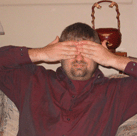I've taken to discussing this sort of thing by saying "with great power comes great responsibility." Kevin says, somewhat more colorfully "Using AutoCAD for scenery is like cutting butter with a chain saw!"
Here is what draws such comments: Perhaps I should forego the quip, and the note on the drawing and just estimate the time required to assure that the instructions are followed. Placing a platform ought to take two people about 15 minutes - get it, locate it on stage, affix it, really nothing can be done in less than 30 minutes but for the sake of the discussion we'll say 15. It won't matter.
Perhaps I should forego the quip, and the note on the drawing and just estimate the time required to assure that the instructions are followed. Placing a platform ought to take two people about 15 minutes - get it, locate it on stage, affix it, really nothing can be done in less than 30 minutes but for the sake of the discussion we'll say 15. It won't matter.
Placing a platform plus or minus 1/64 of an inch I believe would take (in this theatre) something like 110 people, something on the order of four hours. The more precise measuring is fairly difficult and will require more people to make sure that things are left properly as they are affixed. There's also some fairly complex surveying that would need to be accomplished. Plus, the whole thing would need to be done under stage lights, with the proper ventilation, and with an audience to make sure the temperature and humidity conditions don't vary enough to cause thermal expansion of any of the parts.
A difference of 439.5 labor hours and 3.75 linear install hours. Might catch someone's attention.
Monday, January 29, 2007
And Another One of Those Pictures
Subscribe to:
Post Comments (Atom)


5 comments:
i feel like this sort of thing may be inherent in more mouse-based cad programs. while it is not impossible to draft accurately with a mouse in acad (or even in vectorworks, though there are a lot of scenic designers trying to prove me wrong on this one) it seems to encourage inaccuracy
oh I beg to differ...
this has nothing to do with the mouse and everything to do with specific intent and unit precision...
and even moreso to do with paying attention.
I have to agree with David here. I draft daily in Autocad/ADT and often in SketchUp. (Sketchup, btw, is about as mouse based as you can get).
You can draft incredibly precisely in both. The dimension thing is probably 50% about setting up your dimstyle correctly, and 50% about actually drawing correctly, or at least fixing it afterwards.
Then again, concrete tolerances are 1/2" at best.
again: not meaning to suggest that you cannot be precise in mouse-based-cadding; i know this is not true. i am just saying that if people are given an oppurtunity to be lazy many are likely to take it.
while i agree that having unit precision set to /64s should not be necessary because of the ludicrous amount or effort required to ensure that anything were built that precisely, i would much rather err on the side of precision(is there any way for that not to be oxymoronic?) than of sloppiness. i've received far too many drawings with dimensions overridden or set to 1" tolerance creating obvious difficulties for anyone trying to do work based off of these drawings.
Fair enough.
The intention of the dimension is to place a 9" tall platform 8'2-1/2" DS of the back wall. Nobody is going to notice a 5/64th difference. You'll note the other dimension you can see also has a 7/16ths. Probably should be 1/2" there too.
I also think it's more likely that someone is going to misinterpret 27/64ths 1/2", and build it wronger than if it had been simply rounded.
Also, building construction tolerances: the wall you're dimensioning to is accurate to about +/-1/2" if it's concrete or masonry, +/-1/4" if it's steel framed. So if you dimension off the back wall as 8'-2 27/64ths, you can end up anywhere from 8'-2.25" to 8'-2.75" relative to another point on that wall if it's a steel framed wall.
Post a Comment